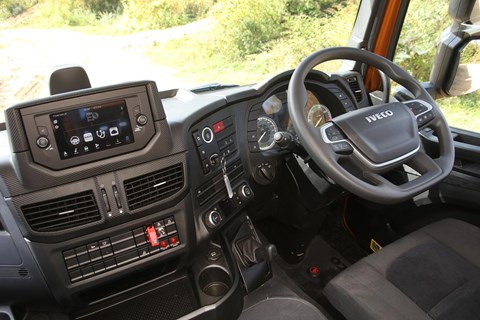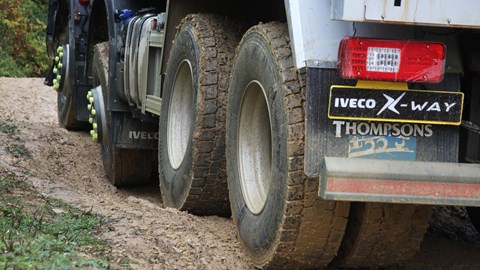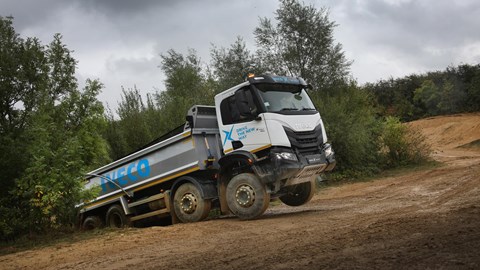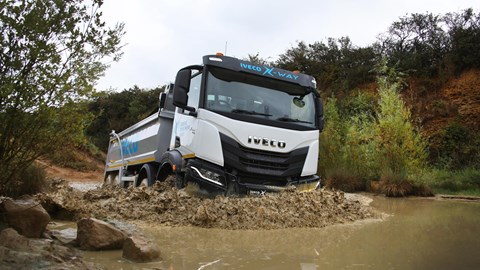► Tackling a quarry in a 32-tonne tipper
► Our van man gets behind the wheel of an Iveco X-Way
► Sliding downhill in something the size of a garage
I’ve always taken the off-roading courses you get on press launches with a hefty pinch of salt. With a few rare and notable exceptions, you tend to get guided around something that the PRs and engineers behind the event are absolutely certain will be within the capabilities of the vehicle being launched. A load of stuck press vehicles would generate entirely the wrong sort of coverage.
The PR man even said that the course for the Iveco Daily 4×4 was designed to be within the van’s abilities, but my attention was already being dragged elsewhere while he was describing it.
You see, all the driving Iveco had planned was off road, which my post-1997 category B driving licence and its pesky 3.5-tonne limit wasn’t an issue here. This meant that I could have a go in the Daily’s bigger, slightly distant, relative, the Iveco X-Way.

The X-Way has eight wheels, a gross vehicle weight of 32,000kg and can carry more than 22,000kg. It’s fair to say it’s somewhat bigger than the large vans I’ve tended to drive. And my first experience of driving something that has a GVW that is almost 10 times bigger than some Ford Transits is to be down steep slopes, through deep water and on loose surfaces. Oh, and it’s raining…
Familiar but different
The experience of driving a 32-tonne vehicle starts before you even get in, with reaching up to the door handle and clambering into the cabin all requiring effort. There are three steps and two grab handles and you’ll need to use both.
Once in, everything is familiar but different to a big car cabin in many ways. There is still a big Fiat-style key, an automatic gearbox and two pedals.

However, it also feels like someone has rearranged your kitchen drawers while you were out – everything is there but in slightly different places. The gear selectors are buttons on a very upright dash set above a parking brake that’s unlike one in any car I’ve driven and the pedals are tucked on the right of a prominent steering column. Then there are loads of buttons that operate things involving hydraulics. I daren’t touch those…
As I desperately tried to remember everything that was being said about how to put the X-Way into the various settings that would deal with the impending quarry, we set off. Pressing D once gets you into auto, while pressing and holding it puts you into semi-auto, where you can change gears manually or, more relevantly, hold it in a gear.
One feature that is definitely familiar but different is the gear selector. There is a large stalk, like a genetically engineered indicator, on the right of the steering wheel. As well as changing gears, it also alters the exhaust retardation and therefore boosts the engine braking.
Onto the mud in road tyres
It all becomes a lot simpler when we start moving – I only have to worry about the steering, brakes and accelerator at that point. And because we’ve kept the X-Way in first gear, it all happens rather slowly, so we crawl down the sort of hill that a lightweight crossover would start picking up pace down.
Everything feels like it is done in an exaggerated manner – gear changes are on a slight delay so they have to be a considered rather than swift decision, while turning requires forethought and plenty of involvement. It takes three turns to get the wheels from one lock to the other, and it is naturally not as snappy as your average hatchback.
What is glorious is quite how unbothered the X-Way is by everything. It just crawls over obstacles, grinds up hills and cruises through water. Albeit slowly.
This is most notable, but not noticeable, when we go over the sort of articulation test that would usually have a 4×4 showing off its differentials by carrying on despite alternating wheels being cocked up in the air. The X-Way’s axles are such that it just keeps wheels on the ground and maintains forward momentum.

The only time wheels come off the ground is when we go over a small hump – the front two wheels get air temporarily but you would never have known it as it just calmly places them back on the floor again.
It was also remarkably unfussed when we paused and had several tonnes of sand loaded into the back by a chap in a digger. You could feel it hunkering down as the weight increased, but it didn’t drastically alter its behaviour once we got moving again.

Moments of disquiet
Before this starts to come across as a total love-in for a big truck, there are some big caveats here. For one, the road biased tyres lose grip really quite easily on a downhill section, meaning we slide to the bottom rather than grind down. Thankfully the footbrake and low overall speed keep everything under control.
Secondly, our truck has a couple of odd moments where it jumps out of gear and shoves itself into neutral when freewheeling down a slope. Not ideal when you’re heading down a slippery hill in a 32-tonne vehicle and want all the slowing-down assistance you can get.

Nothing happened very fast, and we were able to slow it with the brakes and sort it all out when we got onto a level surface, but it would have been a bit hairier if it happened on a longer, steeper hill.
The instructor who did the first loop in the driving seat pointed out that much of this ability is all moot these days as health and safety won’t let drivers head down into the depths of a quarry to pick up their cargo. Instead, they stay safely tucked up at the top and have the sand/stone/rock delivered to them.
Spoilsports.